Don't waste money chasing RAM speed for gaming on AMD or Intel
Revisiting the question that every gamer considers when building a new gaming system: does RAM speed matter?
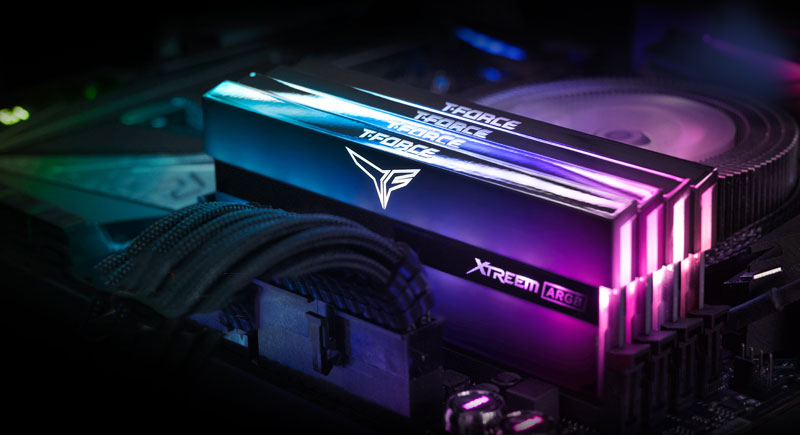
The relevance of RAM speed to PC gaming is one of the most enduring of component discussions. If you're putting together a gaming PC build how much attention and money should you pay towards dropping a chunk of high speed RAM into your rig?
We’re taking a look at a mix of games, some brand new, and one oldies but goodies, to see just how RAM speed affects both Intel and AMD systems in 2020. On paper, faster memory is desirable, but is it really necessary and worth the expense? We all know that a faster GPU will lead to a higher frame rate, and a faster CPU will lessen a potential bottleneck, but RAM speed seems to be one of those things that doesn’t have as clear an answer.
Let’s begin with a look at the system architectures.
AMD and Intel architectures and topology are fundamentally different. The topology in particular has a measurable impact on RAM performance and the resulting bandwidth and latency. As it stands now, Intel CPUs are widely regarded as having an advantage when it comes to gaming performance, particularly at the high end with several models benefiting from 5 GHz+ clock speeds, but that’s not the only reason for Intel’s advantage.
A big part of Intel’s gaming advantage comes from its monolithic die architecture. Having all the cores, cache, I/O, and memory controller on the same die is inherently advantageous for latency, which is usually something that games benefit from.
On the other hand, AMD’s chiplet topology, and accompanying Infinity Fabric interconnect, cannot match the latency that would be achieved on a single die. AMD includes a very large L3 cache to help minimize this deficit (32MB for the 3700X vs 12MB for the i5-10600K). It keeps more data ‘close to the metal’ so to speak.
Some game engines are not sensitive to a few nanoseconds of latency here and there, while others derive benefit from AMD’s very large cache. Others hardly see any benefit at different RAM speeds.
Keep up to date with the most important stories and the best deals, as picked by the PC Gamer team.
Here’s a look at the latency of both Intel and AMD systems tested across various speeds, where the lower the latency the better the result.
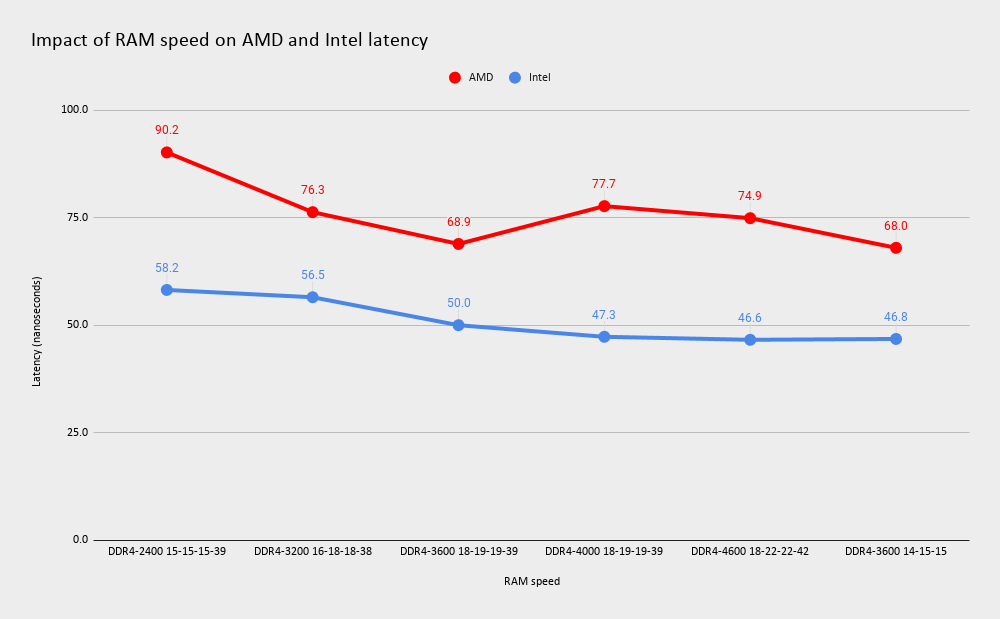
Intel clearly has the advantage here. We also get our first indicator of the ‘wall’ on AMD systems above DDR4-3600. We’ll come back to that. (Spoiler: DDR4-3600 is the sweet spot for AMD Ryzen 3000 systems)
We’ve tested four games. Admittedly it’s not a massive sample size, but they have been selected because they are very different from one another. We’ve got F1 2020, Horizon Zero Dawn, Metro Exodus and finally Civilization VI. They represent a driving game, a third person shooter, a first person shooter and a strategy game.
RAM speed test systems
| Header Cell - Column 0 | Intel test system | AMD test system |
|---|---|---|
| CPU | Core i5 10600K | Ryzen 7 3700X |
| Motherboard | Asus Maximus XII Apex | MSI X570 Godlike |
| Graphics card | Nvidia GeForce RTX 2080 Ti Founders Edition | Nvidia GeForce RTX 2080 Ti Founders Edition |
| Power Supply | Antec HCP-1200 | Antec HCP-1200 |
| Storage | Samsung 860 Pro 1TB (OS) & Western Digital Black SN750 1TB (Games) | Samsung 860 Pro 1TB (OS) & Western Digital Black SN750 1TB (Games) |
| Cooling | NZXT X73 360mm AIO | NZXT X73 360mm AIO |
| Operating System | Windows 10 Pro 64 Bit 2004 | Windows 10 Pro 64 Bit 2004 |
We’ve tested at 3 different settings: 1080p at low settings, 1080p at maximum settings and 4K at maximum settings. This covers a good chunk of use cases.
1080p results at low settings give good information for gamers using high refresh rate monitors. If you’re gaming at 120 fps and higher, you need more than a powerful GPU. A fast CPU—and as we’ll see—quality memory are also necessary.
If you shift to 1080p at maximum settings, you are presented with more of a graphics bottleneck, and at 4K at maximum settings, even an RTX 2080 Ti can and does struggle to put out playable frame rates in some titles.

Intel RAM speed performance

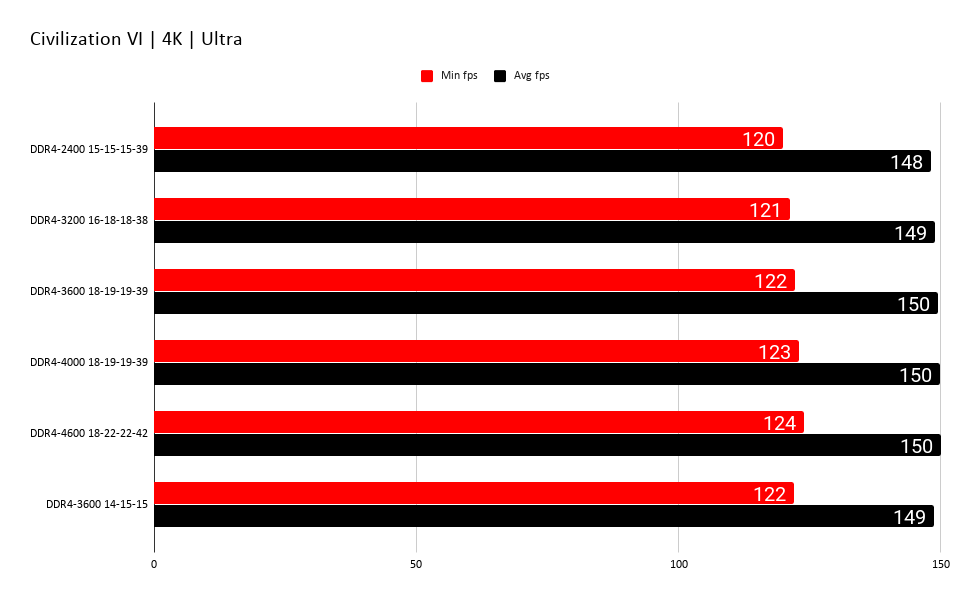


At 4K the system is clearly bottle necked by the GPU. Faster RAM does show some some small minimum FPS gains, but a couple of percent here and there isn’t significant.
At 1080p we start to get a clearer picture. F1 2020 shows that faster RAM has a large impact on performance. Metro Exodus is a very graphically demanding game but even here we see benefits at lower settings. It’s a similar pattern with Horizon Zero Dawn. Civilization VI sees gains too, though very high FPS isn’t as important a strategy game compared to a first person shooter.
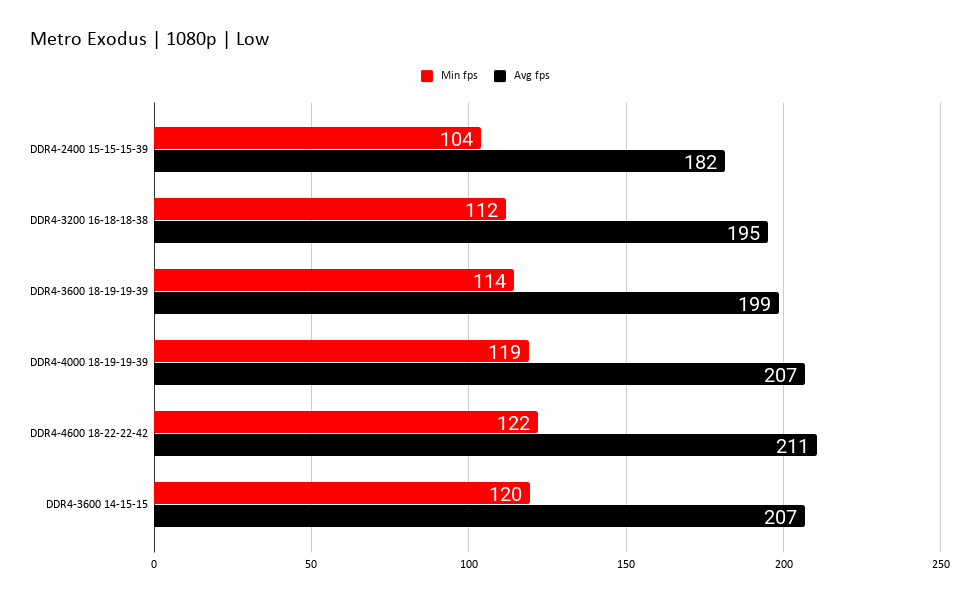


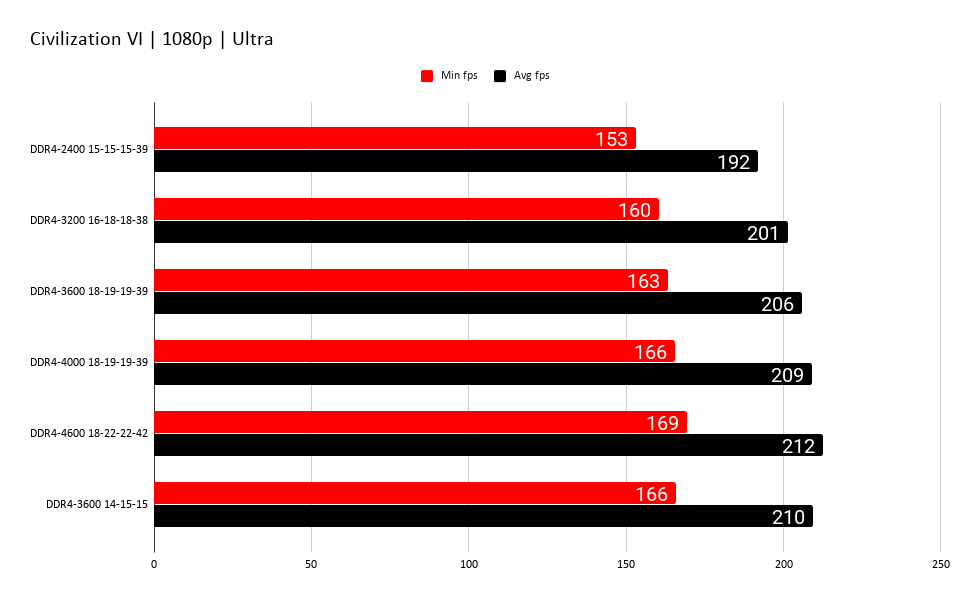



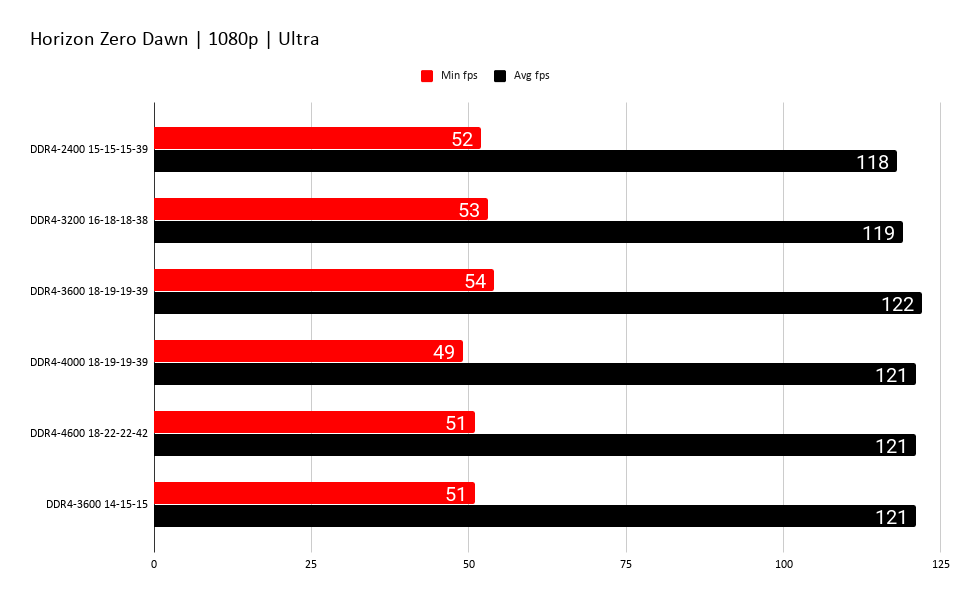
The overall story is clear. For the sake of a few extra dollars or a handful of quid, go with a set of DDR4-3200 and you’ll be all set. It won’t cost much more than 2,400MHz or 2,666MHz RAM. 3,600MHz is about where you start to hit a limit for good value. Kits faster than this tend to really jump up in price. The only reason to go with 4,000 MHz+ RAM is if you’re looking to maximize FPS on a high refresh rate monitor with a similarly high spec system, or you’re chasing points at HWbot.
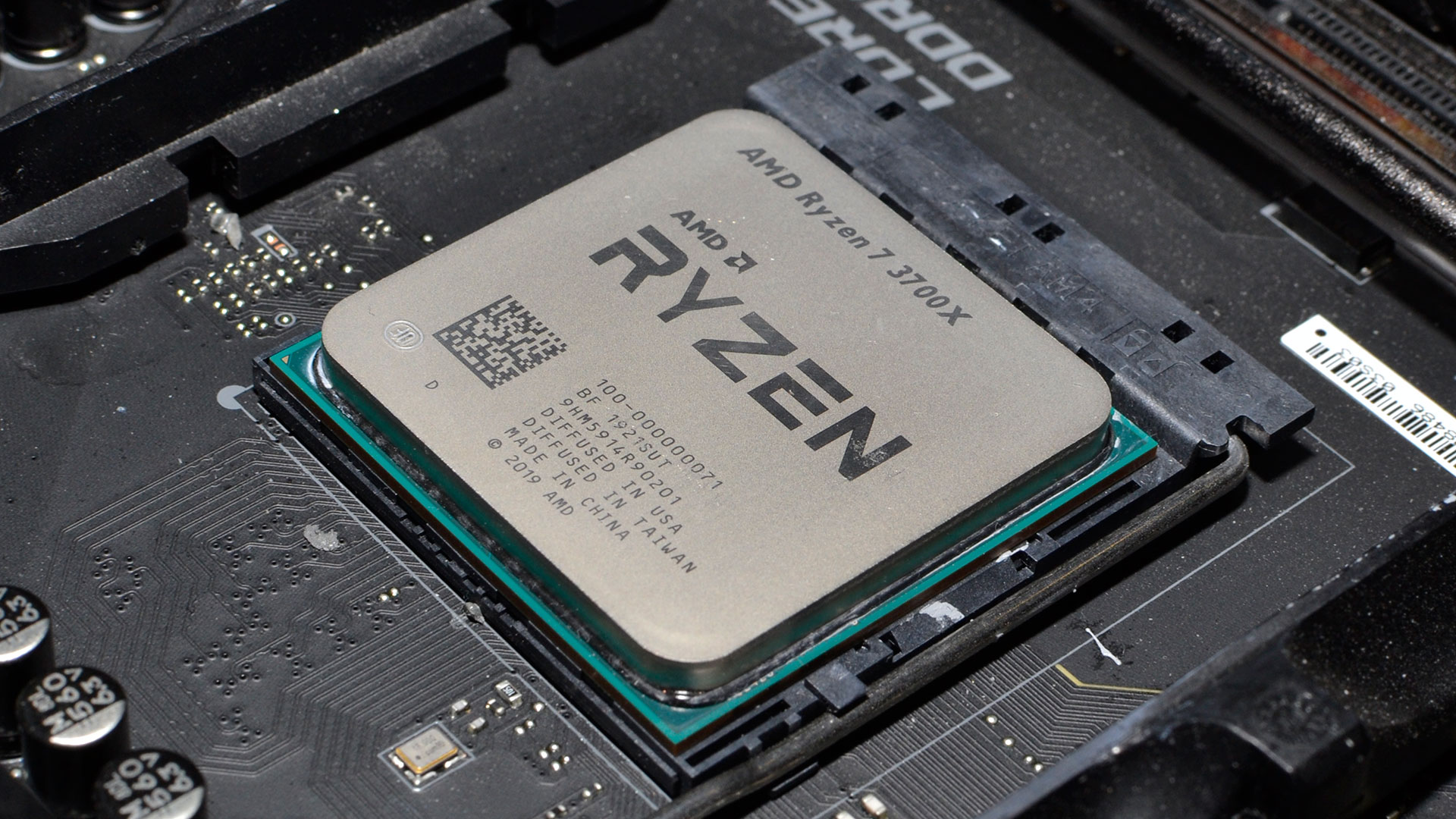
AMD RAM speed performance
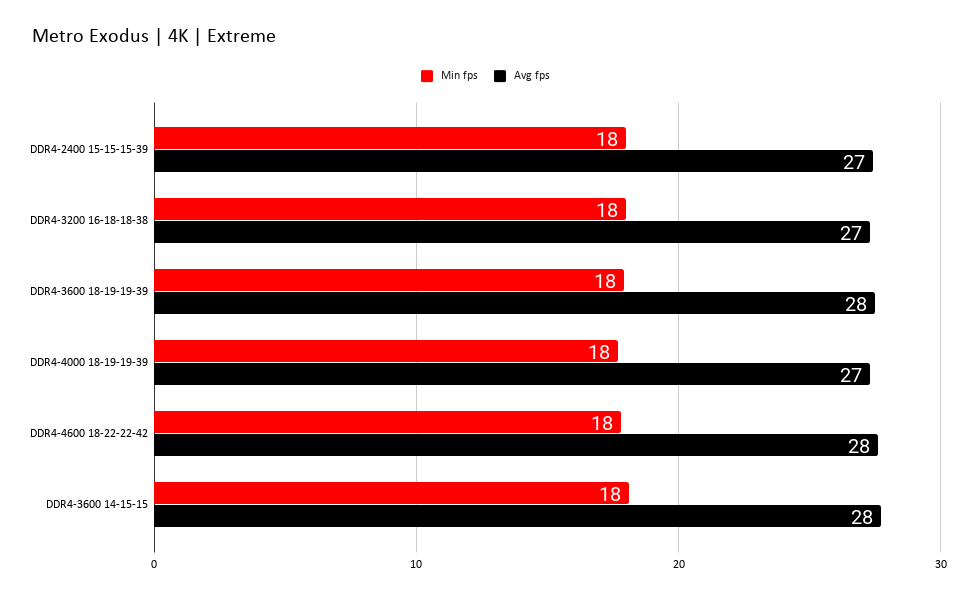

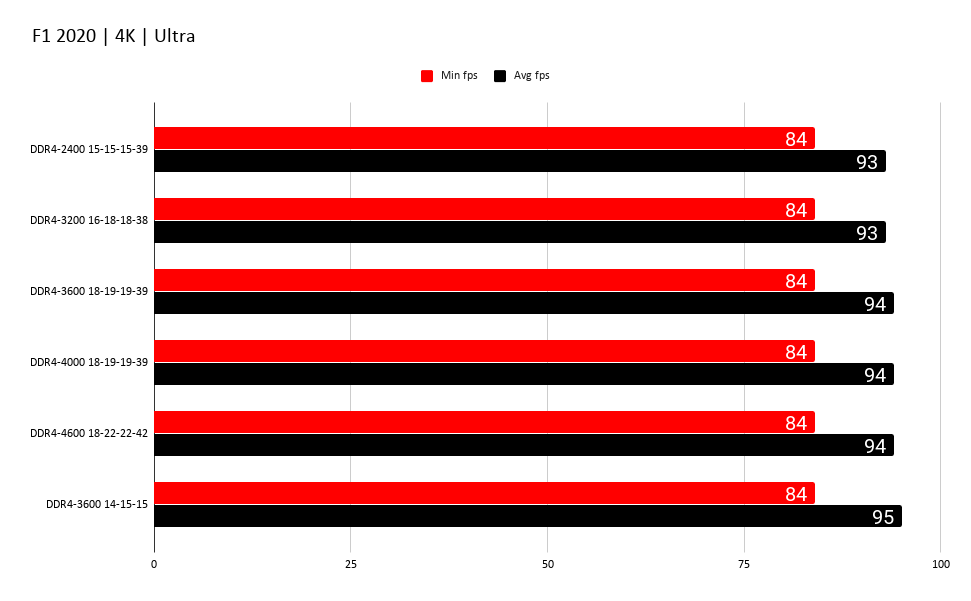

Let’s move onto the AMD system. We see the same general pattern we saw with the Intel system where 4K is highly GPU limited. At 1080p though the results with the slowest RAM are interesting. 1080p gaming with a memory speed of DDR4-2400 appears to show a significant bottleneck. If you’ve got a 120Hz+ monitor, definitely spend a bit extra on some faster RAM.


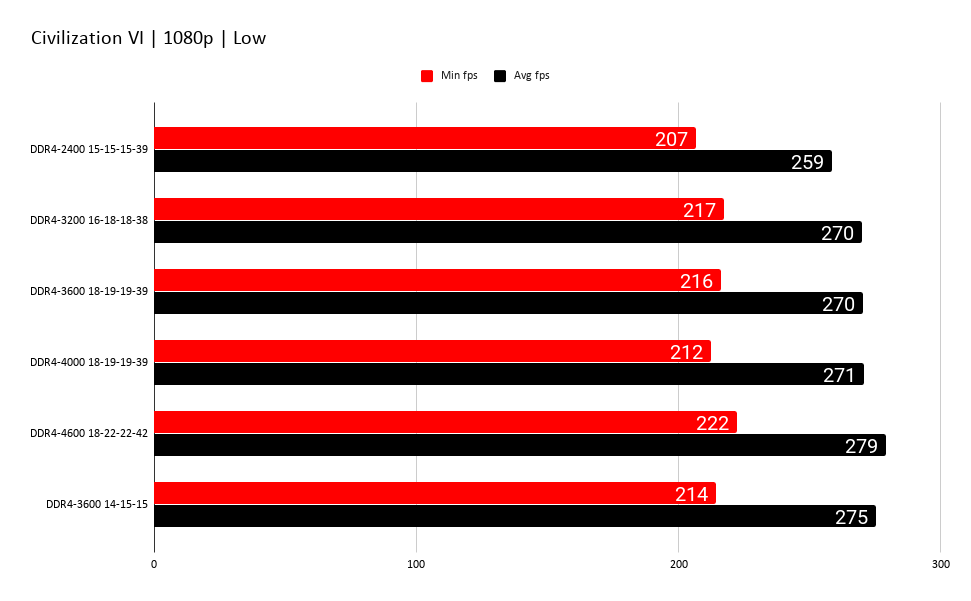

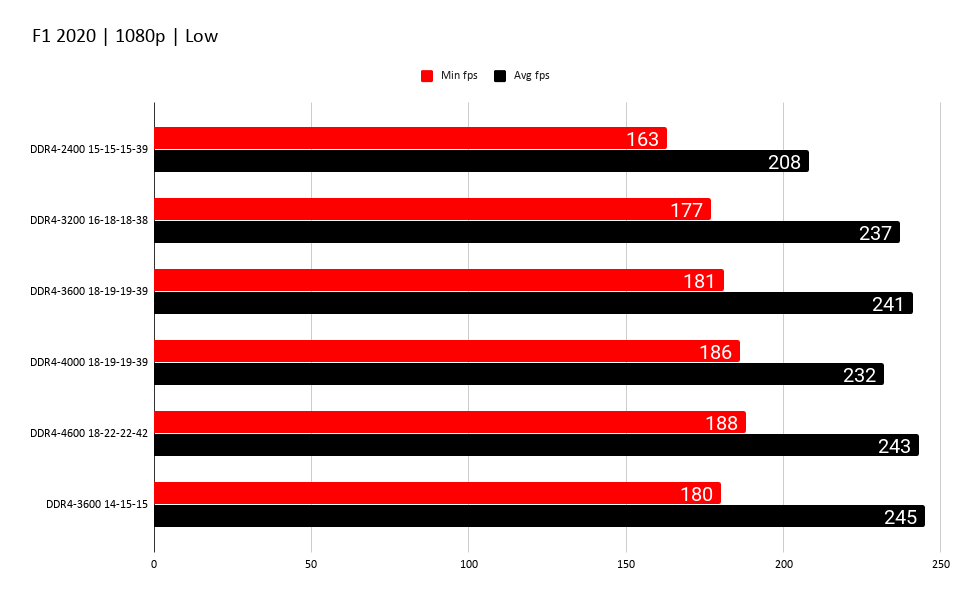


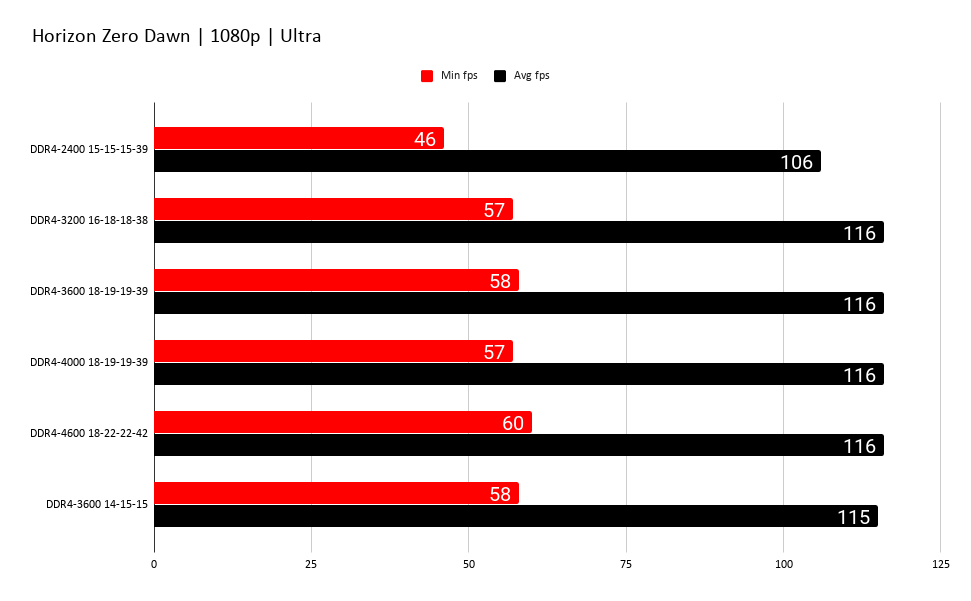
Very fast memory doesn’t make much sense on a Ryzen 3000 CPU
As we mentioned above when looking at the latency results, we see one of the quirks of AMD Matisse CPUs reveal itself above DDR4-3600. The memory clock and Infinity Fabric clock are tied to each other in a 1:1 ratio up to a speed of 3,600MHz. Well, actually it's 3,733MHz if you really want to push it as far as you can go.
If you move beyond this, the motherboard will automatically set the Infinity Fabric clock to 1:2, or half the memory speed. This incurs a latency penalty that we see in the data, with DDR4-3600 generally being slightly faster than DDR4-4000. The difference isn’t huge, but then why would you buy 4,000MHz RAM over 3,600MHz RAM if it’s slower at all? You wouldn’t, and you’ll save a few dollars too. The Infinity Fabric can be set higher than 1,800MHz. Some CPUs can hit up to around 1,900MHz with the IF clock, but that’s still ‘only’ DDR4-3800.
Very fast memory doesn’t make much sense on a Ryzen 3000 CPU.
If you’re a gamer with an AMD Ryzen 3000 system, grab yourself a set of DDR4-3600. Faster RAM is more expensive, it can present some compatibility issues on some boards and at best you’ll see gains that fall into margin of error type of differences. If you’re not interested in overclocking, a 3,200MHz will be fine. 4400MHz+ kits tend to really jump up in price. For a similar price, you can probably get a 32 GB 3,600MHz kit. It’s a no brainer.

To be fair, the same generally applies for Intel systems: most gamers will be fine with a set of DDR4-3200 memory, particularly if you’re running a mid-range GPU. Don’t waste money on very fast RAM if that's the case. Instead divert it towards a better GPU. DDR4 memory pricing is very mature, so there’s little money to be saved by buying a 2,400 or 2,666MHz kit. For us 3,200MHz memory with the common timings of 16-18-18 should be considered the baseline for all but budget systems.
The only reason a gamer should go with very fast 4,000MHz+ RAM is if you’re running a high spec Intel system and you’re into competitive first person shooter games on a high refresh monitor. The real sweet spot is a kit around DDR4-3600 MHz kit with Samsung B-Die IC’s. Something like this Team Xtreem ARGB DDR4 kit we reviewed, with timings of 14-15-15, will fit the bill nicely.
We hope that now you have a better idea of what’s hot and what’s not when it comes to RAM speed. A decent DDR4-3600 kit will suit both Intel and AMD gamers. At that speed you’re getting a good blend of price/performance.
Such RAM will also be widely compatible and easy to set and forget. Will things change with new Ryzen 4000 CPUs or Intel 11th Generation desktop CPUs? Perhaps, but don’t forget that those platforms are likely to be the last DDR4 platforms before we shift to DDR5. Then we’ll all have to start from scratch again!

Chris' gaming experiences go back to the mid-nineties when he conned his parents into buying an 'educational PC' that was conveniently overpowered to play Doom and Tie Fighter. He developed a love of extreme overclocking that destroyed his savings despite the cheaper hardware on offer via his job at a PC store. To afford more LN2 he began moonlighting as a reviewer for VR-Zone before jumping the fence to work for MSI Australia. Since then, he's gone back to journalism, enthusiastically reviewing the latest and greatest components for PC & Tech Authority, PC Powerplay and currently Australian Personal Computer magazine and PC Gamer. Chris still puts far too many hours into Borderlands 3, always striving to become a more efficient killer.

